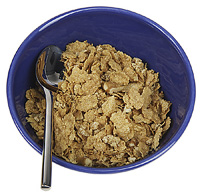Fiber Facts & Fallacies
(Part 1 of 2)
The first time I heard about fiber was in the 1970s, sitting down for a Sunday dinner with my grandparents. After we finished eating, my grandpa poured a glass of water and proceeded to mix some powder into the glass. When he drank it, he closed his eyes, his nose wrinkled up and he contorted his entire face into a sort of grimace.
I asked him why he would drink something that tasted so bad. He said, "It's my daily dose of fiber. I'm drinking it for you because my doctor says it'll help keep me healthy."
It turns out, my grandpa's doctor was right. Decades later, and after dozens of studies, researchers now have a clearer picture of what fiber can do for our health. But first, I want to share with you a couple of things it can't do.
Contrary to popular belief, adding fruit and vegetable fiber to your diet does NOT seem to protect against colorectal cancer. Over the years, there were small studies that appeared to show some promise, but then came the "Nurses Study" conducted by the Department of Medicine, Brigham and Women's Hospital and Harvard Medical School. More than 80,000 women were followed for 16 years. What was the result?
"After adjustment for age, established risk factors, and total energy intake, we found no association between the intake of dietary fiber and the risk of colorectal cancer..." It was a big blow to cancer researchers hoping that fiber might help them in their fight.
The news is also bad for fiber and it's purported "cholesterol lowering" abilities. The Department of Nutrition at the Harvard School of Public Health looked into 67 dietary fiber trials before concluding that the cholesterol-lowering effect of fiber is "small within the practical range of intake" and that "increasing soluble fiber can make only a small contribution to dietary therapy to lower cholesterol." Eating more fiber wasn't going to reduce cholesterol in any significant way.
Remember that when you're reading food labels making claims about their ability to reduce cholesterol. It's mostly marketing hype trying to convince you to buy something that may, or may not be edible. Now for the good news.
Harvard researchers did discover an "inverse association between fiber intake and myocardial infarction." They concluded that "fiber, independent of fat intake, is an important dietary component for the prevention of coronary disease."
In simple terms, what that means is revolutionary. Fiber was shown to reduce the risk of coronary heart disease by an amazing 40%! Just eating more fiber for the heart-healthy benefits alone can potentially save thousands of lives each year.
 The news gets better. The Harvard "Nurses Study" also showed that people who had diets higher in cereal fiber had a lower risk of type 2 diabetes. Something as simple as Wheaties or All-Bran and skim milk can potentially give you years of better health.
The news gets better. The Harvard "Nurses Study" also showed that people who had diets higher in cereal fiber had a lower risk of type 2 diabetes. Something as simple as Wheaties or All-Bran and skim milk can potentially give you years of better health.
If that was all fiber could do, it should be enough to convince everyone they need to eat their recommended daily dose. But, researchers also found fiber can help reduce the incidence of diverticular disease AND (here's the big one) it can even help prevent obesity!
You read that right. Fiber can help prevent obesity. Here's how.
It takes longer to eat high-fiber foods. That gives your body more time to register the food that goes into your stomach and signal your brain you're full. High-fiber meals also tend to be less "energy-dense," meaning they have fewer calories compared to a similar volume of low-fiber food. So if you're trying to lose weight, check out the fiber content of the food you're buying and pick the ones with more fiber per serving.
Want to know more? Now that you know the good and the bad, next week I'll tell you how much fiber you should take in daily, what the two different types of fiber are and the simple steps you can take to get more into your diet.
UPDATE - Fiber Can Prevent Knee Arthritis
Dietary intake of fibre and risk of knee osteoarthritis in two US prospective cohorts - BMJ Publishing Group - Annals of the Rheumatic Diseases - Volume 76, Issue 8 - December 1, 2017
Data from two large studies on osteoarthritis was used to see if fiber had any beneficial effect. Surprisingly researchers found out that people who ate around 21 grams of fiber a day had a 30% lower risk for knee osteoarthritis than participants who ate under 9 grams.
That wasn’t all. Participants who increased their fiber by just 5 more grams (26 grams of fiber daily) had an amazing 61% lower risk for knee osteoarthritis than people who ate under 14 grams daily.
The lead author of the study, Zhaoli Dai, was quoted by The New York Times as saying, “And there are a lot of other benefits as well; reduced weight, reduced cardiovascular risk, and reduced diabetes risk.”
Yet another reason to make sure you’re taking in a minimum 21 grams of fiber daily.
How much do you know about fiber?
Click Here to take our fiber quiz.
Part 1 2
Call for a FREE Consultation (305) 296-3434
CAUTION: Check with your doctor before
beginning any diet or exercise program.
8/12/2007
Updated 3/25/2012
Updated 12/28/2017


